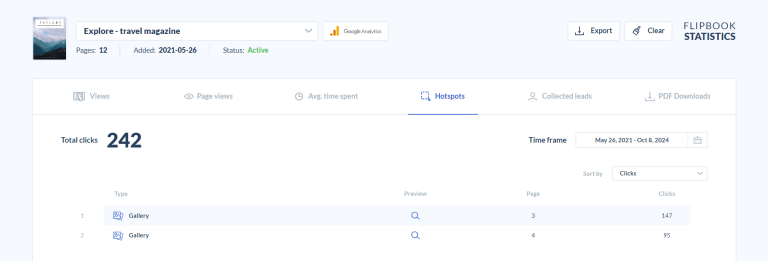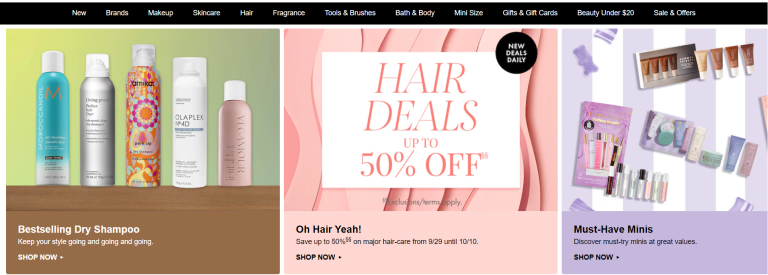What Is a Personalized Content and How to Create It (with Types)
In 2025, capturing and retaining your audience's attention is more challenging than ever. People now have special demands and issues. One powerful strategy that's revolutionizing marketing is personalized content. Whether using a flipbook maker to showcase unique offers or sending personalized newsletters, you can address customer groups directly!

In this article, you’ll learn exactly what content personalization is and how you can use it to your advantage. Keep reading to find out more about personalized content and how it works!
What is personalized content?
Content personalization is a marketing strategy that involves tailoring content to users or specific audience segments based on various data points.
These data points can include:
-
Demographic: age, location, gender, education level
-
Socio-economic: employment status, income
-
Behavioral: purchase history, browsing habits
-
Contextual: stage in the marketing funnel
The goal is to create a more relevant, engaging, and effective experience for each user. This helps customers feel valued and important, which can lead to higher conversions, sales, and customer loyalty.
For example, Amazon might suggest products based on a user's purchase history, or Netflix could use a customer’s name in the subject lines of emails. Online stores can also personalize the user interface or follow up with customers who added products to their shopping cart but didn’t complete the purchase.
How to create a personalized content
1. Understand your audience
Start by analyzing your readers. If you want to personalize your content, you need to know who it's aimed at! Divide your audience into groups based on factors such as where they live, their age, or the stage of their shopping journey. For example, you'll be targeting prospective customers with different content than regular users.
Tools such as Google Analytics or Semrush can help with this. These tools will indicate the age, gender, and location of your readers. You can also use surveys for this purpose. Publuu Analytics also lets you learn who reads your newsletter or magazine, which articles interest them the most, and what times they open it - all of which can be useful in creating segments.

Be careful not to create too many small groups, as this can complicate operations. Many people, for example, point to men aged 25-35 as a popular customer group because this is when people usually finish their education and start balancing work and family life. However, dividing this group into smaller segments (e.g., 26 years old, 27 years old) often makes little sense.
A good tool is to create so-called customer personas. Design a few "sample users," for example, "Aaron, a 32-year-old man from a big city." Imagine how such a person would react to personalized content and what they might need.
💡Read more: How to Find Target Audience
2. Gather valuable information about your readers
Think about what content will be particularly useful to specific groups. Consult your customer service team to find out the most common customer questions and problems. For example, you may find that users of your software are using it differently than you originally intended.
You can also learn what your customers are saying through surveys, reviews, and social media. Take a look at forums or sites like Reddit to see what users are saying about your products, and check reviews on competitor forums or profiles as well.
Another important aspect is understanding how people get to and navigate through your site. Check which links and searches lead users to your store. For example, you would target the group looking for "best tool" differently than those searching for "fast delivery in a big city."
3. Use Publuu flipbooks to tailor your content
Publuu lets you transform your PDFs into engaging, interactive digital flipbooks that are easily accessible on mobile devices, which makes them perfect for sharing personalized content online. These flipbooks allow you to create tailored experiences for your audience by adding interactive hotspots and links that direct readers to specific content suited to their interests or needs.
Publuu’s online flipbook example
View more online flipbook examples
You can also create multiple variants of a magazine or catalog - for instance, one for tourists with links to local attractions, and another for business professionals featuring special offers. This way, your content will be more interesting and matched for your readers' preferences.
Publuu flipbooks can be easily shared on social media, and with robust analytics tools, you can track user engagement. That helps you understand what type of content your target audience prefers, allowing you to create even more effective flipbooks in the future.
4. Plan your strategy
Consider what content will appeal to different groups at various stages of their buying process. For instance, a car dealership might target recent graduates differently than it would target growing families. You should speak a different language to each of these groups. And if someone has been browsing used cars, it's a good idea to offer them a more affordable option.
5. Prepare a tailored content
Create content that directly reaches your target audience. Often, this could be product recommendations based on demographics or previous purchases, but it can also include personalized emails with the customer's name ("Hello, Aaron!"), social media suggestions, or recommended content.
Choose the appropriate format and channel (e.g., social media posts, emails, or ads) depending on your target audience's preferences. For example, graphic design programs should be promoted on platforms like DeviantArt or Behance, while cosmetics should be advertised on sites aimed at beauty enthusiasts.
Tailor your message to the specific interests and needs of each group. Consider: "What would Aaron like to see? If he lives in a smaller city, he might be interested in book deals in addition to movies - because there are often fewer libraries in smaller towns." Plan broadly, but continue to learn from your audience.
6. Test and improve your content
Monitor how effective your personalized content is. Don't give up - regularly improve your messages regularly. Use tools to measure how users respond to your content. Newsletter platforms like Mailchimp often include analytics features that allow you to study the effectiveness of your campaign and conduct A/B tests.
Make changes and improvements based on the data you collect. Remember, your goal is to make customers feel valued and understood, which can lead to more sales and increased customer loyalty.
Types of personalized content
Personalization can take many forms. Here are some of the most popular ways to create content tailored to your users:
Interactive content
Quizzes and surveys help companies gather customer preferences to recommend products or content that match users' interests. Platforms like Pinterest use this approach to suggest relevant content and ads, and thanks to Publuu’s flipbooks and analytics, you can personalize content accordingly for your audience.
💡 Check out our guide to interactive content
GPS-based apps
These apps use the user's location to display personalized information. For example, if a potential customer is searching for “delivery restaurants,” the app will show them nearby options.
Key website pages
Important pages of a site, such as the homepage or landing pages, can be tailored to different customer groups. For example, a clothing store might display different products on the homepage for men and women, or present a different image depending on the time zone (e.g., showing a model admiring the moon at night).
Emails
Personalized emails can include the recipient's name and reference products they have previously viewed or purchased. This makes customers feel appreciated and more likely to make a purchase again. Tools such as Publuu allow you to create highly personalized interactive newsletters.

Remarketing ads
If a user visits a website but doesn’t make a purchase, they may later see ads for those products on other websites or social media platforms.
Product recommendations
Online stores often suggest products based on previous purchases or browsing history. Amazon is a prime example - it analyzes user behavior to provide personalized recommendations.
Social media ads
Ads on social media platforms can be tailored to a user's age, location, and interests. This allows companies to reach a specific audience that is more likely to interact with the brand.
The appearance of buttons and other elements on a website can change based on the user’s profile. For example, special offers or DLC recommendations can be shown to regular customers of a computer game store.
Personalized blog posts
Algorithms can suggest articles to users that match their interests or previous choices. If someone has read the first two parts of a review, they’re likely interested in the third!
Games and apps
Games and apps often use user data to provide personalized experiences. For example, a game may present certain characters to those more likely to identify with them. In the popular game League of Legends, younger players tend to buy Vi skins, while older ones are more likely to purchase Urgot skins.
Benefits of personalized content
In 2025, personalization isn’t just a nice-to-have—it’s expected. Brands that don’t personalize risk falling behind. Here are some reasons to rely on content personalization:
- Better customer experience
- Increased engagement and purchases
- Better perception of your brand
Better customer experience
When content speaks directly to a user's interests and needs, they're more likely to engage with it. They feel understood and appreciated by the brand, which strengthens their loyalty. For example, after purchasing a printer, a customer might receive a discount on ink a month later, encouraging additional purchases.
Increased engagement and purchases
When messages are created specifically for a customer, they are more likely to pay attention to them. This often leads to more purchases. For instance, if a customer views a product but doesn’t make a purchase, a follow-up ad can remind them and prompt reconsideration.
Better perception of your brand
Customers who receive personalized content tend to trust a brand more. This is because they prefer companies that seem to understand their needs. For example, a personalized email with a customer's name and a special discount on a favorite product can make them feel valued and more connected to the brand. Satisfied customers are also more likely to recommend the brand to others.
💡Read more: Building a Powerful Brand Identity
How to deliver personalized content?
Step 1: Know your audience
Before you start creating personalized content, you need to understand who you are targeting with your message. Analyze your site's data, surveys and competitor reports to find out who is visiting your site and what their needs are. Focus on groups that may buy less than others and consider what makes these groups different: location, gender, age, buying habits, or goals.
Step 2: Create the right message
Once you know who your audience is, prepare tailored content for them. Think about their needs and how you can make their lives easier. There is no one-size-fits-all approach to creating content—it all depends on the group and the product you offer.
For example, in a gaming store's newsletter, you can create different messages: one for occasional gamers and another for those who regularly spend more. For the first group, you might highlight attractive promotions, while for the second, you can emphasize their value as customers by offering exclusive deals. Remember to send messages only to those who have given you permission to do so.
Step 3: Evaluate effectiveness
Regularly check whether your personalized content is having the desired effect. Use Publuu's email sending tools or analytics to help you segment your audience, write messages, and test their effectiveness. If the first results are positive, continue testing to improve further.
Also, try different strategies for communicating with customers - for example, you can replace the traditional newsletter with flipbook distribution from Publuu. Return to Step 1 to identify new groups you can reach. Over time, your content will become more tailored and more effective at reaching specific audiences.
What is an example of personalized content?
Netflix

Netflix and chill is an option for everyone, and this website has gained great popularity thanks to personalization. When a user finishes watching a particular series, Netflix offers them similar productions: “Fans of the Stranger Things series often also watch...”. What's more, if a user has interrupted watching a video, Netflix reminds them where they left off and encourages them to continue.
Spotify

Spotify creates a personalized playlist for each user every day, including songs they might like based on their listening history. Such playlists are also created at the end of the week, summer vacation and at the end of the year. Many users often share their playlists, which in the end helps to promote the company
Amazon

You probably have seen the famous “Customers who bought this product also bought...” section - Amazon displays this section on each product page, suggesting similar or complementary items that may be of interest to the customer. For example, when you buy a new game console, the page starts suggesting games and accessories.
Amazon also displays a “Products you've looked at recently” section, reminding the user of previously viewed items. You can also receive emails with special offers on products tailored to your shopping history and preferences.
Sephora

Well-known cosmetics conglomerate Sephora is also big on personalized customer experience. It offers its customers quizzes to help them select the right beauty products. Based on the answers, the customer receives personalized recommendations.
Thanks to augmented reality technology, customers can virtually try on various products to see how they will look in real life.
Personalized content FAQ
How to write personalized content?
Writing personalized content involves several key steps:
-
Know your audience: Use contextual data and customer feedback to understand potential customers.
-
Segment your audience: To understand customer behavior use personalization strategy relying on personas.
-
Match the tone and language to audience: Using personas, learn how to adapt the style to match these groups.
-
Use hard data: Customer data can help you make crucial decisions.
-
Apply dynamic content: Use content that changes based on user behavioral data or other characteristics.
-
Constantly test: Improve and test your personalization strategy to consistently suit the needs of your customers.
Is personalized content good?
In general, personalized content is beneficial for both business owners and customers. Businesses report increased engagement rates, higher conversion rates, and overall better ROI on marketing efforts.
Customers find more useful content and feel understood by brands. However, your content personalization strategy must be well thought out: it shouldn’t overwhelm the customer and should respect their privacy.
Conclusion
Personalized content is ideally suited to your customers - but to create it you need to know what your customers like and give them exactly that. When you do that, your products are more likely to reach them.
You need to use information about your readers to give them the best possible experience, create things they'll love and pay attention to how they respond. This takes time and effort, but it's worth it.
Companies that can create personalized content well will be the most successful.
You may be also interested in:
Marketing Strategy: What It Is and How to Create One in 2024